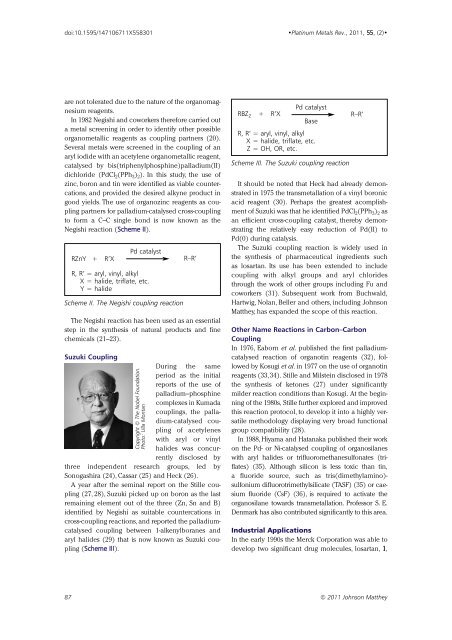Download - Platinum Metals Review
Download - Platinum Metals Review
Download - Platinum Metals Review
You also want an ePaper? Increase the reach of your titles
YUMPU automatically turns print PDFs into web optimized ePapers that Google loves.
doi:10.1595/147106711X558301<br />
•<strong>Platinum</strong> <strong>Metals</strong> Rev., 2011, 55, (2)•<br />
are not tolerated due to the nature of the organomagnesium<br />
reagents.<br />
In 1982 Negishi and coworkers therefore carried out<br />
a metal screening in order to identify other possible<br />
organometallic reagents as coupling partners (20).<br />
Several metals were screened in the coupling of an<br />
aryl iodide with an acetylene organometallic reagent,<br />
catalysed by bis(triphenylphosphine)palladium(II)<br />
dichloride (PdCl 2 (PPh 3 ) 2 ). In this study, the use of<br />
zinc, boron and tin were identified as viable countercations,<br />
and provided the desired alkyne product in<br />
good yields. The use of organozinc reagents as coupling<br />
partners for palladium-catalysed cross-coupling<br />
to form a C–C single bond is now known as the<br />
Negishi reaction (Scheme II).<br />
Pd catalyst<br />
RZnY + R’X R–R’<br />
R, R’ = aryl, vinyl, alkyl<br />
X = halide, triflate, etc.<br />
Y = halide<br />
Scheme II. The Negishi coupling reaction<br />
The Negishi reaction has been used as an essential<br />
step in the synthesis of natural products and fine<br />
chemicals (21–23).<br />
Suzuki Coupling<br />
Copyright © The Nobel Foundation.<br />
Photo: Ulla Montan<br />
During the same<br />
period as the initial<br />
reports of the use of<br />
palladium–phosphine<br />
complexes in Kumada<br />
couplings, the palladium-catalysed<br />
coupling<br />
of acetylenes<br />
with aryl or vinyl<br />
halides was concurrently<br />
disclosed by<br />
three independent research groups, led by<br />
Sonogashira (24), Cassar (25) and Heck (26).<br />
A year after the seminal report on the Stille coupling<br />
(27, 28), Suzuki picked up on boron as the last<br />
remaining element out of the three (Zn, Sn and B)<br />
identified by Negishi as suitable countercations in<br />
cross-coupling reactions, and reported the palladiumcatalysed<br />
coupling between 1-alkenylboranes and<br />
aryl halides (29) that is now known as Suzuki coupling<br />
(Scheme III).<br />
Pd catalyst<br />
RBZ 2 + R’X R–R’<br />
Base<br />
R, R’ = aryl, vinyl, alkyl<br />
X = halide, triflate, etc.<br />
Z = OH, OR, etc.<br />
Scheme III. The Suzuki coupling reaction<br />
It should be noted that Heck had already demonstrated<br />
in 1975 the transmetallation of a vinyl boronic<br />
acid reagent (30). Perhaps the greatest acomplishment<br />
of Suzuki was that he identified PdCl 2 (PPh 3 ) 2 as<br />
an efficient cross-coupling catalyst, thereby demonstrating<br />
the relatively easy reduction of Pd(II) to<br />
Pd(0) during catalysis.<br />
The Suzuki coupling reaction is widely used in<br />
the synthesis of pharmaceutical ingredients such<br />
as losartan. Its use has been extended to include<br />
coupling with alkyl groups and aryl chlorides<br />
through the work of other groups including Fu and<br />
coworkers (31). Subsequent work from Buchwald,<br />
Hartwig, Nolan, Beller and others, including Johnson<br />
Matthey, has expanded the scope of this reaction.<br />
Other Name Reactions in Carbon–Carbon<br />
Coupling<br />
In 1976, Eaborn et al. published the first palladiumcatalysed<br />
reaction of organotin reagents (32), followed<br />
by Kosugi et al. in 1977 on the use of organotin<br />
reagents (33,34). Stille and Milstein disclosed in 1978<br />
the synthesis of ketones (27) under significantly<br />
milder reaction conditions than Kosugi. At the beginning<br />
of the 1980s, Stille further explored and improved<br />
this reaction protocol, to develop it into a highly versatile<br />
methodology displaying very broad functional<br />
group compatibility (28).<br />
In 1988, Hiyama and Hatanaka published their work<br />
on the Pd- or Ni-catalysed coupling of organosilanes<br />
with aryl halides or trifluoromethanesulfonates (triflates)<br />
(35). Although silicon is less toxic than tin,<br />
a fluoride source, such as tris(dimethylamino)-<br />
sulfonium difluorotrimethylsilicate (TASF) (35) or caesium<br />
fluoride (CsF) (36), is required to activate the<br />
organosilane towards transmetallation. Professor S. E.<br />
Denmark has also contributed significantly to this area.<br />
Industrial Applications<br />
In the early 1990s the Merck Corporation was able to<br />
develop two significant drug molecules, losartan, 1,<br />
87 © 2011 Johnson Matthey
















